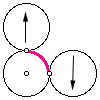The beaver makes 4 complete somersaults as the nickel makes its journey.
 |
The key observation is that for every degree that the rolling coin moves around the edge of a fixed coin, the beaver turns 2 degrees! One way to convince yourself of this is to place two coins of the same size so that the upper coin touches the top of the fixed coin (at the 12:00 position), and its pattern is right-side up. Rolling the upper coin about the fixed coin you'll see that its pattern points down when it has gone 1/4 of the way around the fixed coin (touching it at the 3:00 position). It points up again at the halfway point (at 6:00), down again after 3/4 (at 9:00), and right side up again when back at the start. Thus the pattern flips over twice during the 360o journey. |
A more complete discussion of this property of rolling circles can be found in Rolling Circles, an answer to a question that we received at Quandaries and Queries. An elementary mathematical treatment can be found in Jack Eidswick's artlicle "Two Trisectrices for the Price of One Rolling Coin,"The College Mathematics Journal, 24:5 (November 1993), pages 422-430.
Now here is the solution by Jack Yeh:
The rolling nickel can only touch 1/3 of the perimeter of each outside nickel. (This observation follows from the symmetry of the figure). The beaver therefore makes 2/3 of a somersault as it rolls about the first nickel. There are 6 outside nickels. Thus 6 * 2/3 = 4 somersaults will be completed.
Appropriately enough, we took this problem from Stan Wagon's Problem of the week (= POW). Wagon's past problems (without solutions) can be found on Math Forum's web page
http://forum.swarthmore.edu/wagon/
You can subscribe to Macalester University's POW e-mail list by sending e-mail to
majordomo@forum.swarthmore.edu
with ONLY the following words in the message body: subscribe macpow
Our MP1 with a solution can also be found in the book Which Way Did the Bicycle Go? by J. Konhauser, D. Velleman, and S. Wagon (published by the Math. Association of America); it contains 191 problems and solutions selected from the Problems of the Week from 1968 to 1995.
Other Solvers.
Although several correct solutions were submitted to us, only Jack Yeh and David Xiao provided satisfactory explanations. Remember that with the solution to any mathematical problem, the explanation is all-important – every claim must be supported by some mathematical truth.